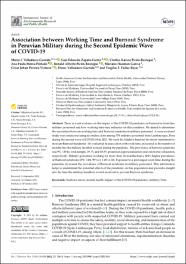| dc.contributor.author | Valladares-Garrido, Mario J. | es_ES |
| dc.contributor.author | Zapata-Castro, Luis Eduardo | es_ES |
| dc.contributor.author | Picón-Reategui, Cinthia Karina | es_ES |
| dc.contributor.author | Mesta-Pintado, Ana Paula | es_ES |
| dc.contributor.author | Picón-Reategui, Ronald Alberto | es_ES |
| dc.contributor.author | Huaman-Garcia, Mariana | es_ES |
| dc.contributor.author | Pereira-Victorio, César Johan | es_ES |
| dc.contributor.author | Valladares-Garrido, Danai | es_ES |
| dc.contributor.author | Failoc-Rojas, Virgilio E. | es_ES |
| dc.date.accessioned | 2023-02-06T17:27:45Z | |
| dc.date.available | 2023-02-06T17:27:45Z | |
| dc.date.issued | 2022-10-20 | |
| dc.identifier.uri | https://hdl.handle.net/20.500.13053/7753 | |
| dc.description.abstract | There is scant evidence on the impact of the COVID-19 pandemic on burnout in front-line military personnel and how working time may influence on this condition. We aimed to determine the association between working time and Burnout syndrome in military personnel. A cross-sectional study was conducted using secondary data among 576 military personnel from Lambayeque, Peru during the second wave of COVID-19 in 2021. We used the Maslach Burnout Inventory instrument to measure Burnout Syndrome. We evaluated its association with work time, measured as the number of months that the military member worked during the pandemic. The prevalence of burnout syndrome was 9%. Of the total sample, 39.1% and 10.3% presented depersonalization and emotional exhaustion, respectively. Military personnel working for more than 18 months had a 104% higher prevalence of Burnout syndrome (PR: 2.04, 95%CI: 1.02–4.10). Exposure to a prolonged work time during the pandemic increased the prevalence of Burnout syndrome in military personnel. This information helps to understand the potential effects of the pandemic on this population and provides insight into the time the military members would need rest to prevent Burnout syndrome. | es_ES |
| dc.format | application/pdf | es_ES |
| dc.language.iso | eng | es_ES |
| dc.publisher | MDPI | es_ES |
| dc.rights | info:eu-repo/semantics/openAccess | es_ES |
| dc.rights.uri | https://creativecommons.org/licenses/by/4.0/ | es_ES |
| dc.subject | burnout; stress; mental health; impact of the COVID-19 pandemic; military; Peru | es_ES |
| dc.title | Association between Working Time and Burnout Syndrome in Peruvian Military during the Second Epidemic Wave of COVID-19 | es_ES |
| dc.type | info:eu-repo/semantics/article | es_ES |
| dc.identifier.doi | https://doi.org/10.3390/ijerph192013614 | es_ES |
| dc.type.version | info:eu-repo/semantics/publishedVersion | es_ES |
| dc.publisher.country | CH | es_ES |
| dc.subject.ocde | http://purl.org/pe-repo/ocde/ford#3.03.00 | es_ES |


